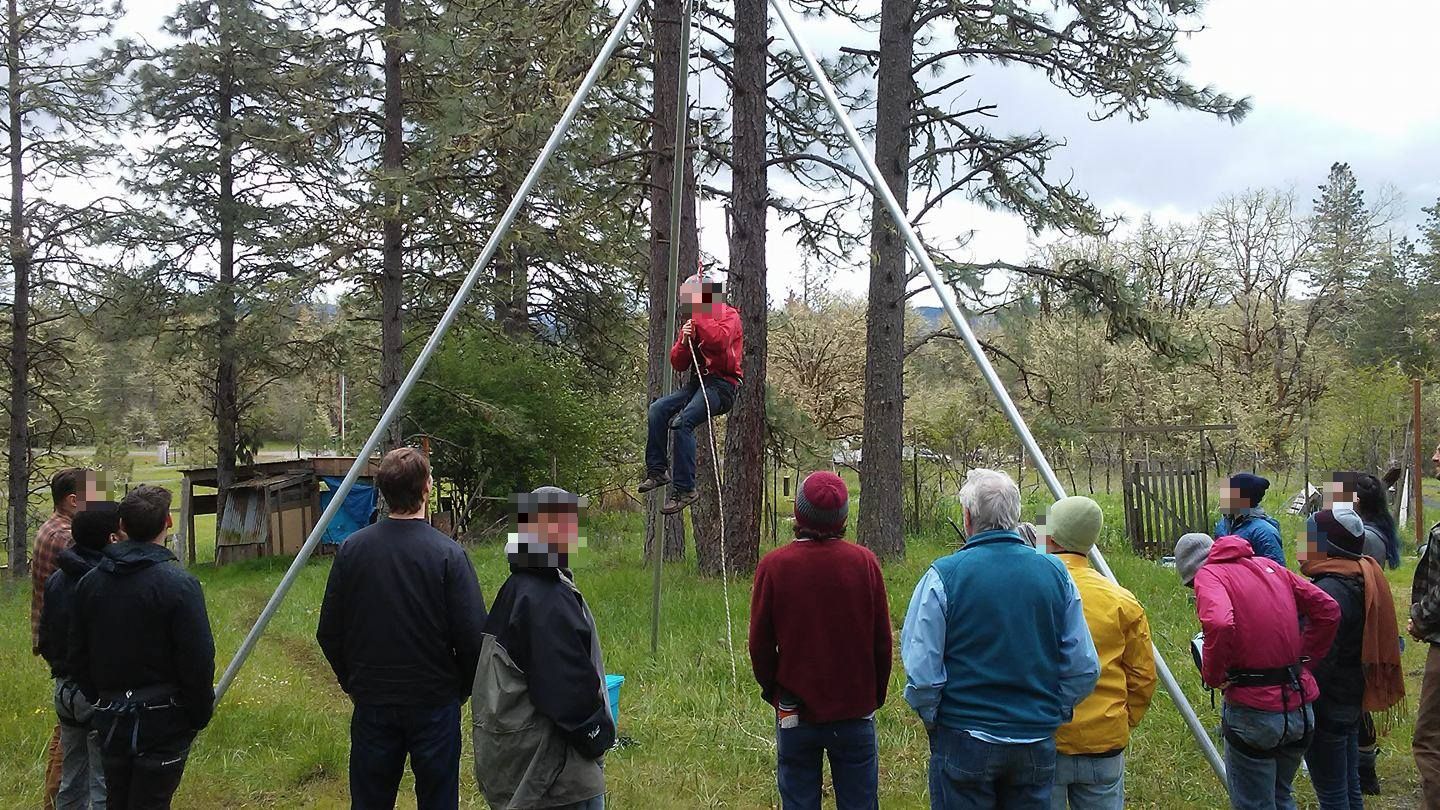
by DGR Editor | May 2, 2017 | Education
by Deep Green Resistance Eugene
Over Earth Day weekend, Deep Green Resistance members in Oregon hosted an advanced direct action training in rural western Oregon.
About 45 people attended from several surrounding states.
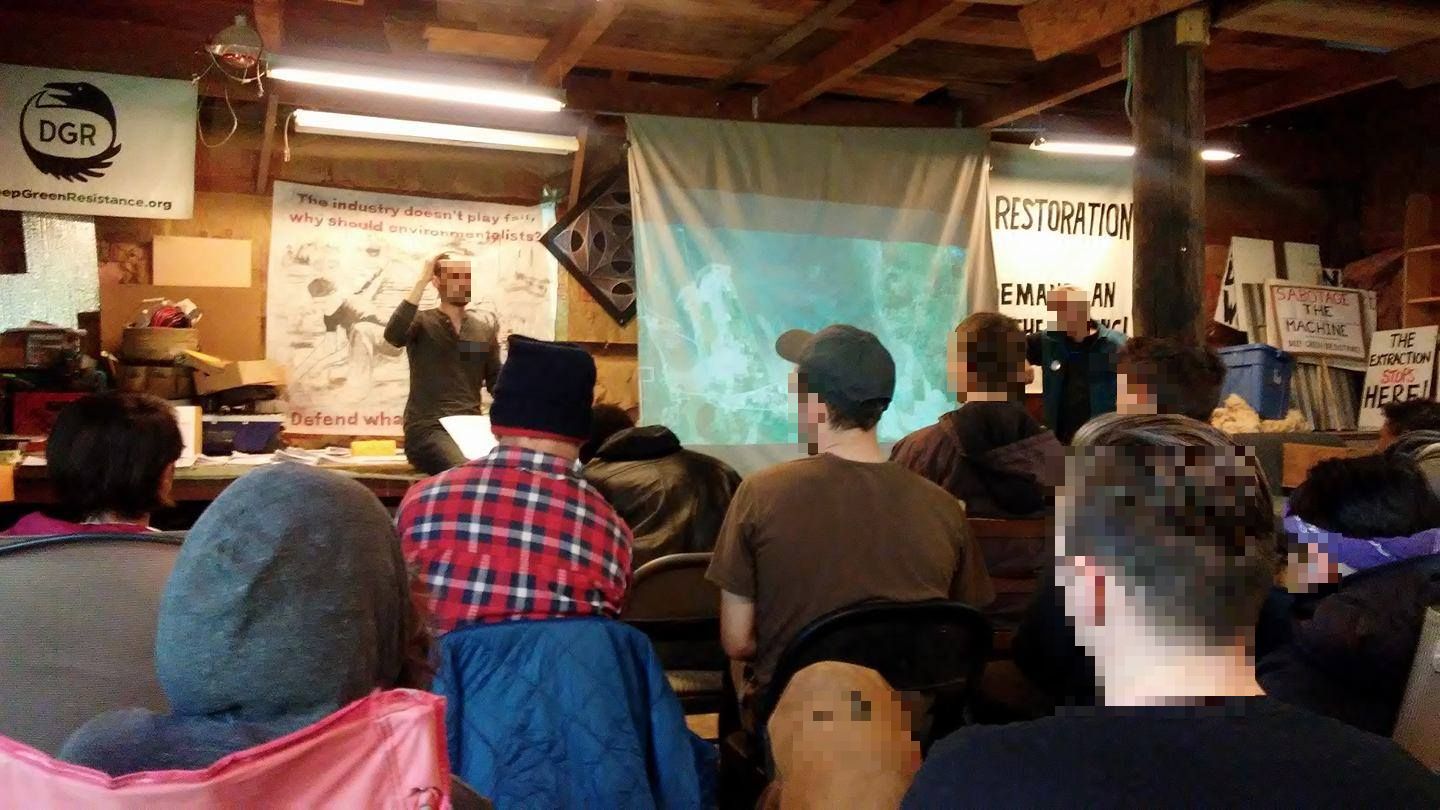
This workshop broke down critical factors and possible improvements for various recent and historical resistance actions and campaigns.
The training began with several anti-oppression sessions to help foster an equitable and safe environment for facilitators and participants, especially for people of color, women, indigenous people, and members of other oppressed and marginalized groups. These sessions, which included an introduction to radical feminism and a group activity around understanding privilege, aimed to inform the interpersonal dynamic and content of the training. This is also to help facilitate a more inclusive and comfortable organizing experience in our communities.
Other training sessions included:
• Campaign strategy
• Target selection
• Case studies in two recent direct actions from people involved in them
• Analysis of critical factors in other recent and historical resistance campaigns / actions
• Scouting for action
• Know your rights and legal briefing
• Art and resistance
• Media
• Various hard skills for blockades and direct action
• Communications and digital security
• Affinity groups
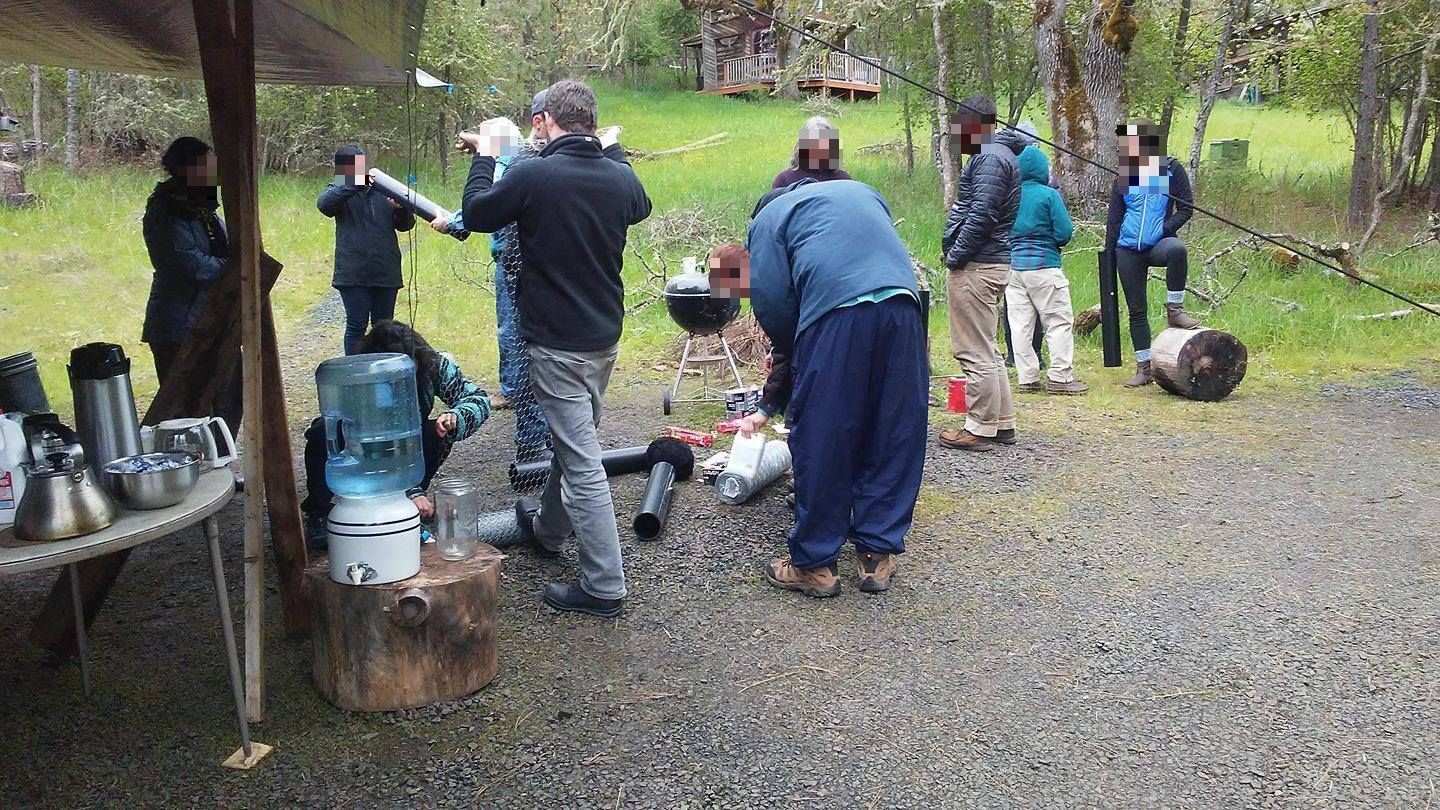
Experimentation with building materials for blockades.
Trainings like this play an important role in developing two critical elements in effective resistance: community and skills.
This sort of event would be impossible without financial support. To everyone who donates to Deep Green Resistance, is a monthly sustainer, or purchases gear from our website—thank you!
A few comments from attendees:
“Thank you… for such a comprehensive training in just a few days!”
“I considered not coming when I saw some militant photos on the DGR website, but I’m so glad I did. This training really debunked the myth of resistance activists being casually militant and violent people.”
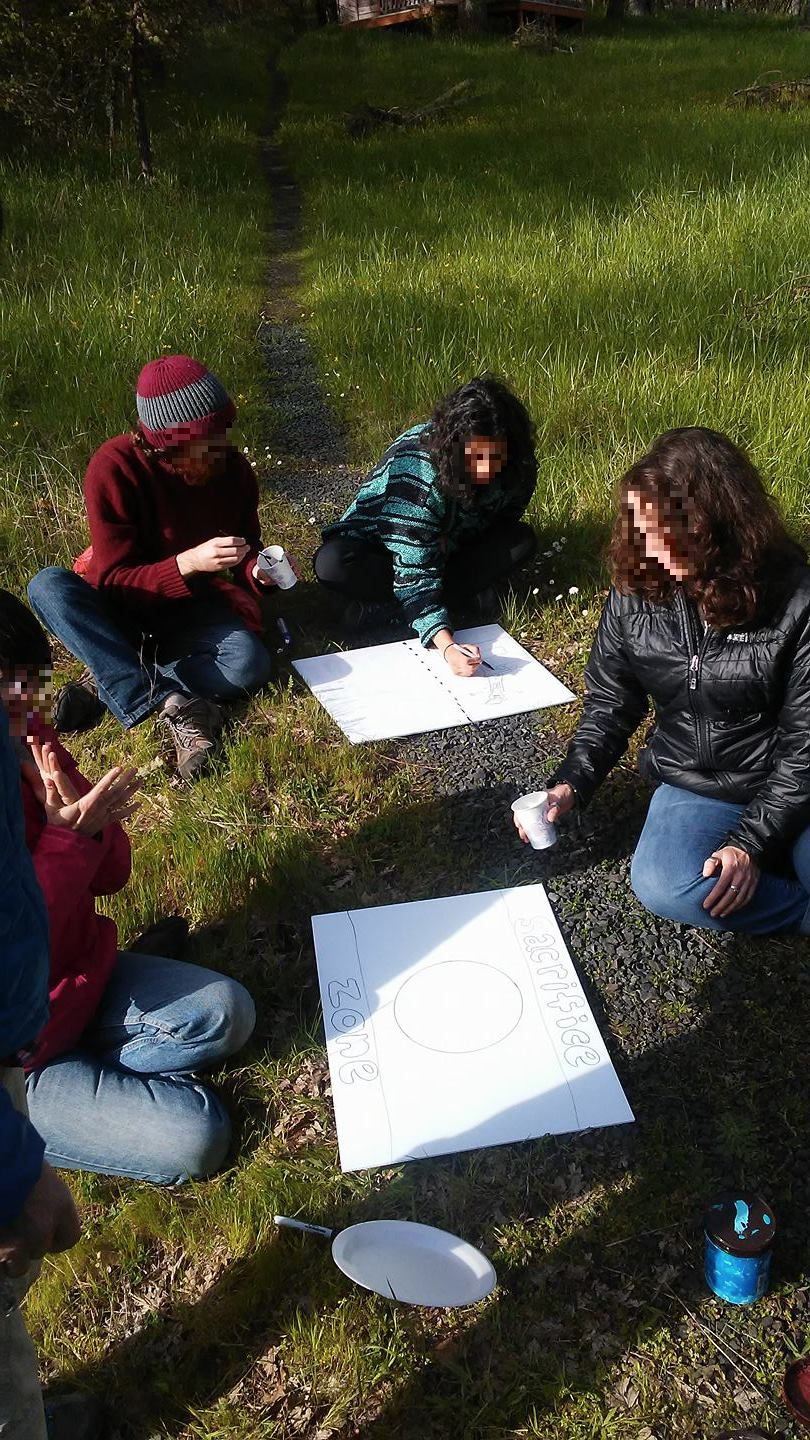
Artistic workshop after a long day sitting down inside.
“My daughter has been telling me for years about radical feminism and I never understood what she was talking about. I do now, somewhat, and I am aware of all I don’t know and hadn’t considered in terms of the climate crisis and potential steps I can take. I’m so glad I came.”
“I could spend weeks hearing and discussing the topics brought up on Saturday morning, and I learned a lot. The Privilege Walk was powerful and a great way to start the weekend. Thank you for the RadFem reading list and the matter-of-fact presentations on intersectional oppressions!”
“Awesome group of people at the training.”
“I’m home and full of inspiration… You have my deepest appreciation for the hours of hard work it took to make this weekend happen. The whole crew of you are simply wonderful, thank you for being dedicated enough to take bold actions and wise enough to do them prudently.”

Tripod and rope ascending workshop.
“The DA training offered an invaluable opportunity for DGR members and allies to meet in person, share ideas and skills, and build real community. Each new relationship felt like a door opening to our greater collective potential and previously unconsidered ideas. There is something magical in spending time together that cannot be quantified or explained. I can’t wait for the next get together and to see the inspiring ideas and actions that will surely come out of this training.”

by Deep Green Resistance News Service | Apr 29, 2017 | Education
by Max Wilbert / Deep Green Resistance Great Basin
As a kid, I pictured Nevada as a wasteland of sand and cacti. Today, I know better.
For the past five years, I’ve been packing up my truck every spring and taking a long day to drive to eastern Nevada to bask in the glory of one of the least densely-populated areas of the United States.
The broad valleys never fail to stun me, but most amazing are the mountains, limestone peaks arcing into the sky. Springs and creeks flowing from the hills support rich riparian zones and bring in birds and other wildlife from miles around. Antelope, deer, elk, and wild horses cross the valleys or stick to forested patches. This region is lush, biodiverse, and beautiful.
It’s also under threat. Across eastern Nevada, the Southern Nevada Water Authority seeks to build dozens of massive groundwater wells and pump almost every drop of water south to feed Las Vegas developments. The project has been a battle between locals and developers from Vegas for decades, and still drags on.
Another major threat is felling pinyon pine and juniper forests across not just this region, but the entire intermountain west. Ranchers have been doing this for decades to remove pesky trees getting in the way of their grass—and more importantly, their profit. As overgrazing continues to desertify Nevada—it’ll look like Iraq in another 100 years—removing trees allows ranchers to maintain the illusion that overstocking can continue indefinitely.
Countless people, including myself, are mobilizing to fight like hell for this land, this water, and these forests. We aim to stop these destructive projects by exposing their true nature and—if necessary—standing in their way.
There is a lot more to these stories, but I don’t have time to share it all here. Instead, I’d like to invite you to join myself and other community members, indigenous people, activists, ecologists, photographers, and families for the fifth annual Sacred Water, Sacred Forests Camp.
The camp takes place over Memorial Day weekend, May 27 to 29, near the town of Ely and Great Basin National Park. If you’re interested in attending, you can RSVP on the Facebook event page or by emailing greatbasin@deepgreenresistance.org.
I hope to be able to introduce you to this important, imperiled area in a few weeks.
—
Max Wilbert is a community organizer based in western Oregon who considers Nevada a second home.
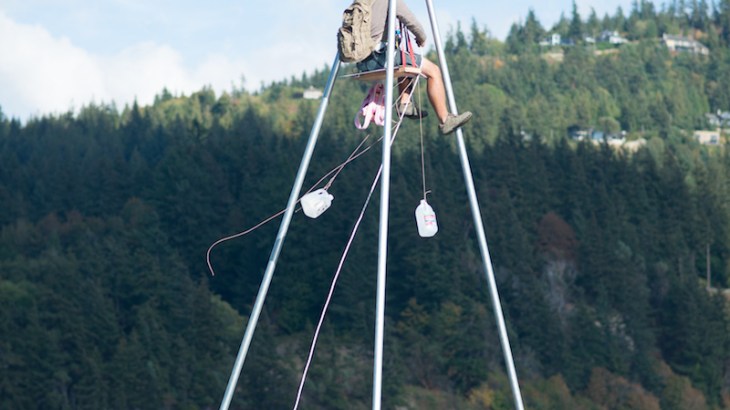
by Deep Green Resistance News Service | Mar 12, 2017 | Movement Building & Support
by Erin Moberg / Deep Green Resistance Eugene
On Wednesday night, DGR Oregon members hosted an Open House for all activists and community members interested in meeting active DGR members, sharing a meal, talking politics and activism, and learning how to get (more) involved. Our goal was twofold: (1) to continue our work to normalize and demystify direct action as a viable and necessary offensive strategy to fight back against the culture of empire and (2) to publicize and register guests for our upcoming Advanced Direct Action Training over Earth Day Weekend (April 21-23) outside of Eugene.
For other DGR chapters and members interested in hosting a similar event, here are some reflections on what worked well and what we’d do differently next time:
- Hold open house in a central, public space. We reserved a free, local community meeting space, rather than holding the open house at one of our houses.
- Require RSVPs for event location details. This way, you can vet interested individuals and activist groups, and (ideally) have an approximate head count, ahead of time.
- Provide snacks and drinks, rather than a full meal. We put together an impressive and delicious potluck spread for guests, including lamb stew, several salads, Mexican casserole, and chocolate brownies! While it was well-appreciated by those who attended, in hindsight the time it took to prepare and transport the food and drinks could have been better spent on more impactful DGR-related work.
- Make one-on-one connections with guests. As activists, we know that a significant barrier to leaving our comfort zones and exploring radical activism is the fear of social/community ostracization and isolation. By holding an open house, we were able to meet people individually and face-to-face and form personal, human connections before transitioning into the heavier content of radical environmentalism, radical feminism, direct action, etc.
- Provide DGR reading materials. We set up our typical tabling display for guests to explore, including a trifold display about DEW, copies of Deep Green Resistance, and pamphlets on DGR, feminism, indigenous communities, the people of color caucus, and more.
- Include an informative visual presentation and member introductions. We welcomed guests with a slideshow playing on a loop; it included photos of past DGR actions, members, and messaging, as well as some relevant videos. After sharing a meal, the organizers introduced ourselves and reflected individually about our interests and involvement in DGR. This was an opportunity for us to speak to: DGR history, strategy, local chapter focus, and upcoming events. This brief presentation also helped to personalize DGR and debunk any circulating myths about DGR as an underground, or anarchist, or specifically pro-violence movement.
- Be prepared to intervene if a (male) individual coopts the conversation or event. It’s important to model for activists new to DGR what a feminist-informed discussion and space look and feel like. Even though it can be uncomfortable, decide ahead of time who the unofficial “moderator” will be if the conversation is derailed or becomes tense or aggressive, and especially in the case of misogynist or racist behavior or statements. Don’t leave it up to the women to assume this role (unless we volunteer in the first place)!
- Expect no-shows. By the day of the open house, we had around 30 RSVPs, which was a much higher number than we’d anticipated! However, only 9 guests actually showed up, so we spent a lot of time preparing way too much food and materials.
- Follow-up with guests as soon as possible. Make sure that all guests sign in, and make plans to follow up with guests individually soon after the event.
Our open house was productive in that we met and had conversations with several people who plan to attend our direct action training next month. Several guests asked thoughtful questions, offered informed opinions, and were very appreciative of the work we do as activists. The event also helped to foster community building within DGR Oregon itself, especially for new DGR members. On the whole, however, we agree that we could have spent less collective time organizing this event in order to dedicate more time to other activist work with a (potentially) more immediate impact in our community or in halting the destruction of the planet.

by Deep Green Resistance News Service | Feb 19, 2017 | Education, Movement Building & Support
by Erin Moberg / Deep Green Resistance Eugene
On Saturday, February 4th, several members of DGR Oregon attended a day-long NVDA training in Eugene, Oregon. The event was organized by local and regional activists. Over 200 people attended, including local activists, community members new to direct action, college students, youth, retired people, and others from nearby towns.
DGR members attended this training as part of an increased effort to connect with Eugenians from other activist groups and to invite community members to two upcoming events: (1) a DGR Open House in downtown Eugene (March 8) and (2) an Advanced Direct Action Training to be held just outside of Eugene over Earth Day weekend (April 22-23). We also, of course, wanted to see what we could learn.
The Keynote Speaker was Leonard Higgins, who shared a short film documenting his experience as one of the “valve turners” who shut down oil pipelines in five states in October of 2016. Higgins described direct action as “not the only important work to be done” but crucial in that it supports other activist work, including: changing the economy, transitioning to alternative energies, and expanding community organizing strategies. Although his remarks and the entire training focused on “preserving life as we know it and civilization” and “ensur[ing] a future for human civilization,” Higgins and the film did help to normalize and demystify direct action for those new to environmental activism.
People who want to support the valve turners can attend a legal costs fundraiser event on the evening of February 24th at 6:30pm at the First Methodist Church near downtown Eugene. The suggested donation for the event is $20, but no one will be turned away for lack of funds.
The workshops (Medic Training, Encryption Basics, Jail/Arrest Support, Action Planning, “Artivism,” and more) emphasized peaceful resistance toward the end of sustaining or bettering life for human beings. Even when referencing the Water Protectors at Standing Rock, there was no concrete mention of the destruction of the land and little reference to the occupation of indigenous communities and territories by the culture of empire. While this may be simple omission, it’s a trend in mainstream activist groups—especially in predominantly white groups—to avoid naming the problem, and to avoid being “negative.”
Most frustrating in the workshops was the lack of organization and structure; many facilitators had poor presentational skills, little understanding of key semantic nuances of relevant terminology (ie: violence, use of protective force, and violation), and an overall lack of consciousness around anti-oppression strategies necessary to foster equitable engagement and collaborative environments.
This is unsurprising, as in our experience mainstream activist groups and NGOs such as this often serve as a sort of buffer against truly revolutionary change by funneling energy, donations, and volunteers into minor reforms.
In the workshop on Action Planning, the facilitator (a Portland-based activist) did share several strategies that could be useful for DGR meetings, direct action trainings, and forum culture. One is the acronym WAIT/WAINT (Why Am I Talking? / Why Am I Not Talking?), a variant of the Step Up/Step Back framework designed to encourage those who occupy positions of privilege and tend to dominate (white people, men, documented folks, etc.) to hold space for those whose voices and experiences are often silenced or ignored (people of color, women, undocumented folks, etc.). She also explained the “Points of Intervention Model” as way for activists to identify how, where, and when to plan a concrete direct action. This model asks organizers to consider points of production (ie: labor site), destruction (ie: mines), consumption (ie: households), decision (ie: corporate head), assumption (ie: segregated spaces), and potential before then deciding on:
- vision –> (2) campaign–> (3) strategy–> (4) tactic–> (5) action
Her example was:
- Stop climate change–> (2) Halt proposed pipeline construction–> (3) pass anti-pipeline legislation–> (4) forums, petitions, lawsuits–> (5) Not specified during the workshop
While the training was a good first step for first-time activists interested in learning more about political organizing, this day of workshops didn’t provide a compelling vision of the application of political power. For those with little to no activist experience, there were no clear articulations of the history, potential, and goals of direct action. For those who attended as experienced activists, there were no hands-on workshops offered for specific direct action skills trainings (ie: how to build and use lockboxes). The legal presentations, encryption info, and medic training did offer concrete skills that are valuable to organizers. In terms of community representation at this event, there were no facilitators of color, few female facilitators, and few opportunities designed to connect training participants one-on-one.
Overall, this training focused on issues leading up to or arising in the aftermath of direct actions, not the actions themselves. For organizing large groups to achieve reforms, it was a potentially useful training. However, for people interested in deep revolutionary changes, it was lacking.
Thanks to the organizers for hosting this event.
People interested in learning more advanced skills should contact DGR Eugene to inquire about our advanced direct action training scheduled for Earth Day weekend, April 22-23.
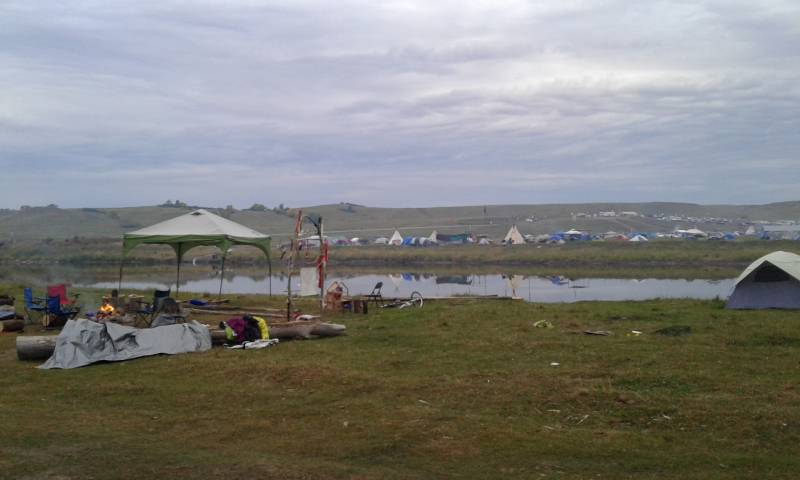
by Deep Green Resistance News Service | Nov 9, 2016 | Culture of Resistance
by Jennifer / Deep Green Resistance
I have traveled to Standing Rock twice now. The first time was on September 16 – 20. On the first trip I went with my mother. We camped at Rosebud and spent a great deal of time in the kitchen preparing food and talking with members of the camp, indigenous and non-indigenous allies. We could hear prayers and drumming in the Oceti Sakown Camp well into the night. The atmosphere was of constant prayer and felt celebratory. There were fireworks on the first night of our stay. I visited Sacred Stone and the “Overflow,” Oceti Sakowan, camps. Between Rosebud and Sacred Stone a women’s lodge was being constructed, with the permission of the elders.
The second trip was on October 29 – November 2. I went with acquaintances and we camped in the Oceti Sakowan. We fed ourselves, and provided our own shelter. The only time I ate outside of our camp was when I went to do dishes at Rosebud. Surveillance was present on the hill overlooking the camp: flood lights, drones, plane helicopter circling. I did not take pictures. The camp itself was much quieter. I attended non violent civil disobedience training, a requirement for all new arrivals. I filled out forms with legal and prepared for the possibility of NVCD action.
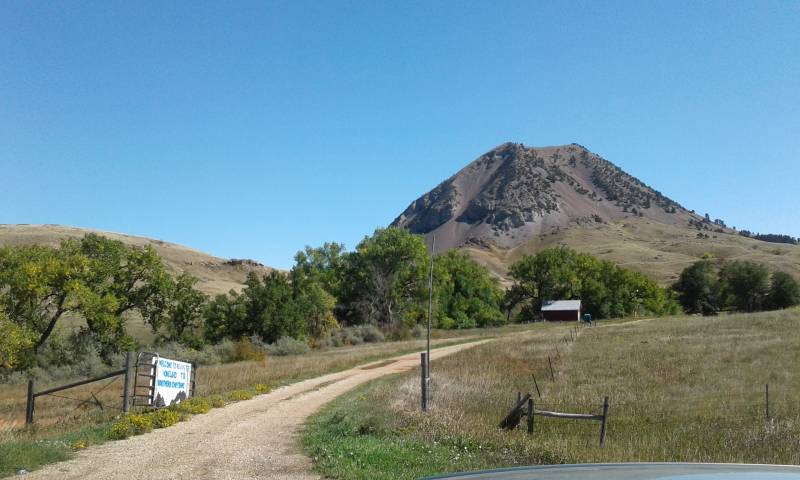
I also went to an orientation for the medics. Currently a Medic tent, herbal/alternative remedy, and a body work tent have been established with a mental health group and center in formation. Meetings for the camp are held every morning and in a truly respectful and democratic manner. All voices are heard. From 2-3 hours of work a day are expected to be given to the collective. I participated in water ceremony by invitation. I gave my drum when it was asked for, to be in sweat lodge. I visited Sacred Stone, and spoke with a keeper of the sacred fire who had just returned to camp, having closed down her life a half a continent away to be at Standing Rock.
Building for the winter was well underway. Between Sacred Stone and Rosebud on the Standing Rock Reservation side of the Cannonball, the women who were building the women’s lodge had returned and were well established; the lodge was complete. Rosebud looked the same physically, but many people who I remembered had left while some remained. I had a brief conversation with a Episcopalian Minister letting me know that 300 faith leaders were answering the call to come to Standing Rock. Over 500 arrived the day after our departure.
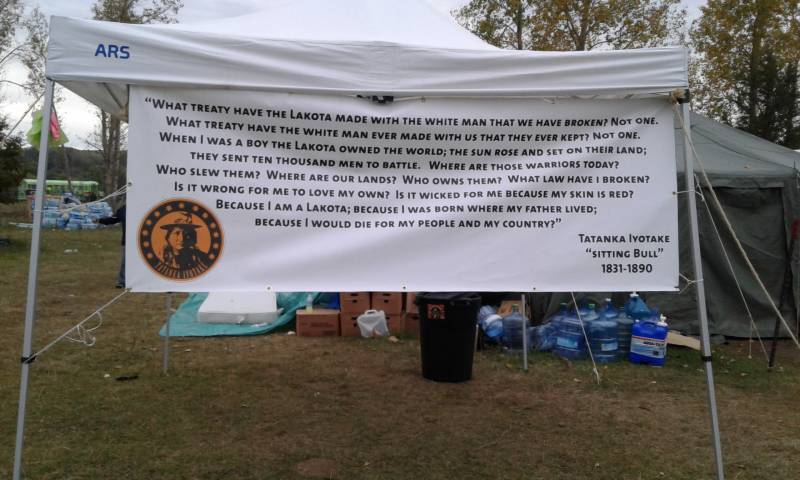
I was physically cold, in pain, and sleep-deprived during the stay. Monday was particularly difficult and windy. Recent tests indicate I most likely have a severe form of arthritis. Fortunately be were camped by some trees and able to create a bit of a wind break. If you are planning to go, be prepared for harsh conditions and be realistic about your limitations and how to deal with them.
I have attended multiple Wednesday evening updates at Four Winds in Denver. I have learned a great deal about the legal and on-the-ground struggles, not only at Standing Rock but historically, by attending updates. These meetings have also led to engagement with an organizing group of women who coordinated Four Directions March and Prayer in solidarity with Standing Rock and on Indigenous Peoples Day (transforming Columbus Day), prayer and ceremony for Murdered and Missing Sisters, and on election day will be holding a Million Mothers March in Denver. I have been able to engage in support work by request and have been able to offer air time through WomynAir and the AM News Magazine on our local community radio station KGNU to increase awareness and notify the public when it is appropriate for them to attend.
In Conclusion: Standing Rock is a functional, resilient community of resistance. Standing Rock is prayer and ceremony and community. If there is anything that I have gathered from having been at Standing Rock it is this. Prayer and ceremony unite the people to the land, air, and water; to each other, to our ancestors, to community, to action. It is my belief, after my experience of being at Standing Rock, that this foundation gives humans the strength and sanity to face ourselves, our communities, life, and to continue to take action in defense of life. Words fail. I will continue to listen.










